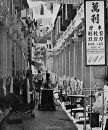We've tried to ensure the information displayed here is as accurate as possible. Should there be any inaccuracies, we would be grateful if you could let us know at info@ipohworld.org . All images and content are copyright.
(Please click on the thumbnail for a bigger image.)
Panglima Lane, Lane Of The Second Concubines (Written In 2008)

This photograph shows Panglima Lane known less formally by Ipoh’s residents as Second Concubine Lane. It is decorated by laundry hanging on poles between the upstairs of opposite houses in the traditional Chinese manner. At ground level there is more laundry in evidence and what is probably a hawker pushing his cart of wares.
In fact there are three lanes in Old Town which historically have similar tales to tell. They are First, Second and Third Concubine Lane, or officially Hale Lane, Panglima Lane and Market Lane. From the early days of the tin mining coolies, right up to and through the Japanese Occupation, the three lanes were said to be full of brothels, gambling houses and opium dens. There is no doubt that at one time there were such establishments in the lanes although those who remember growing up there also remeber family homes, coffee shops and small tradesmen's workshops as well. Legend has it that whenever an opium addict dropped dead, his corpse would be thrown out of the window and into the street, waiting for council sweepers to cart it away in the morning.
Opium dens and brothels were licensed by the government and many Tin Mining Towkays held such licences. Hence, the poor coolie laboured in the mines to earn a few cents and then paid the money back to the Towkay for his evening’s entertainment. The final injustice was the legendary depositing the body in the street, rather then paying funeral expenses.
The name "Second Concubine Lane is said to have come about as Yau Tet Shin, who developed New Town, kept his second wife there until the New Town houses were ready. An interesting twist to this story is that when New Town was ready for occupation, nobody wanted to live there as the area had been full of stinking pigsties and mosquito-ridden padi fields. Consequently the Government moved the licensed brothels from Old Town to New Town across the river and not surprisingly coffee shops and other establishments that catered for the mining coolie soon sprouted up. New Town was soon a bustling area.
Eventually opium was banned (thanks to the efforts of the Perak Anti Opium Society) and stricter anti-vice laws introduced. Post war the lanes took on a new role as housing for the concubines of the rich Towkays, hence the local names.
Panglima Lane is the most picturesque of the narrow streets in Old Town, but today (2008) is in a serious state of disrepair and if this is allowed to continue one of the most interesting parts of Ipoh’s history will be lost to the nation forever.
To learn more about Yau Tet Shin, click here.
To learn more about the Perak Anti Opium Society, click here.